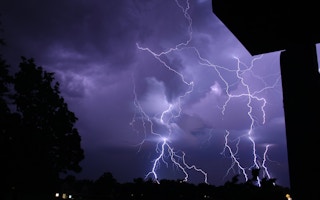The residents of Gurwaith village in Indian Kashmir never used to fear thunderstorms, but in recent weeks, people have raced home or remained indoors at the sight of dark clouds overhead.
Lightning killed four villagers on May 6 - two people herding sheep and a couple working on their farm - marking the first time the area has experienced a lethal storm as climate change fuels the risk of more frequent strikes across India.
“People are scared following the (May) incident,” said Saif-u-Din Dinda, a farmer in the village in Budgam district. “Everyone … rushes home when the weather turns bad.”
Fellow villager Khadija Begam, whose husband Mohammad Sultan Chopan was one of the four victims, said the couple “used to get caught in thunderstorms while herding our sheep”.
“But, no one was ever killed by lightning,” she said.
Thunderstorms and lightning have emerged as major weather hazards in recent years, killing about 2,500 people annually, India’s National Disaster Management Authority (NDMA) says, with those in rural areas or working outdoors most at risk.
Lightning is the biggest killer among “forces of nature” - which also include avalanches, cyclones and landslides - accounting for 40 per cent of 7,126 such deaths in 2021, according to the latest data from the National Crime Records Bureau (NCRB).
As temperatures rise and droughts worsen worldwide, lightning strikes are becoming more frequent not only in India but nations ranging from Nepal and Brazil to the United States.
“
Our main focus is to create awareness among people that the best defence against lightning is avoiding staying outdoors during lightning. Our major challenge remains people who work outdoors - farmers, herders, fishermen - and children in rural schools.
Sanjay Srivastava, convener, Lightning Resilient India Campaign
More extreme heat can draw more moisture into the atmosphere and encourage rapid updraft – two key factors for charged particles, which lead to lightning.
And in India - where lightning is common in the rainy season - longer dry spells between bouts of torrential rain are resulting in more frequent strikes, research has shown.
Sunil Pawar, a scientist at the Pune-based Indian Institute of Tropical Meteorology (IITM), said the frequency had risen by between 20 per cent to 35 per cent across various regions of India since 2019, due to global warming as well as worsening air pollution.
“As climate change is expected to cause more heatwaves in coming years, the lightning strikes are also expected to increase further,” Pawar said.
A 2021 report by the Lightning Resilient India Campaign (LRIC) said there were 18.5 million lightning strikes between April 2020 and March 2021, a 34 per cent rise on the previous year.
Officials say the government has sought to reduce lightning deaths by investing in detection sensors and providing area-specific information about strikes through a mobile app, but experts such as Sanjay Srivastava of the LRIC are calling for more to be done to raise awareness and protect the public.
“Our major challenge remains people who work outdoors - farmers, herders, fishermen - and children in rural schools,” said Srivastava, convener of the LRIC, which is a joint initiative between various organisations and government bodies including the NDMA and the Indian Meteorological Department.
Raising awareness as lightning risk grows
Climate scientists worldwide are sounding the alarm about the risk of global warming increasing the frequency of lightning strikes - and the impact this could have on related disasters such as forest fires.
For example, Canada is in the spotlight as it braces for its worst-ever wildfire season. At least 3.3 million hectares (8.2 million acres) have burned so far this year, and Quebec province is the hardest hit due to multiple fires ignited by lightning.
In India, a 2021 study published in the journal ‘Atmospheric Chemistry and Physics’ said that by the end of the century, lightning frequency is set to rise by between 10 per cent and 25 per cent, while its intensity is expected to increase by between 15 per cent and 50 per cent.
India suffers huge human casualties from lightning compared to developed countries, experts have said.
About two people in a million die from lightning in India each year, yet in the US and Australia, for example, that figure is 0.1 per million, according to 2016 research published by Vaisala, a Finnish weather and environmental products firm.
India should follow the example of the US, where safety campaigns, readily-accessible weather information and research into the causes of lightning casualties have hugely cut the number of deaths in recent decades, said Rohit Chakraborty of the Divecha Centre for Climate Change, a research institute.
The nation must also consider how its development and growth is exacerbating the root causes of extreme weather, he added.
“India and other developing countries, which are rapidly creating infrastructure and urban areas besides more transport and industries, also need to adopt clean (carbon-free) development models as they seek to grow,” Chakraborty said.
“This will be the best solution for dealing with heat generation or climate change which is causing more natural disasters such as lightning.”
Srivastava of the LRIC said he expected lightning deaths to fall in India this year due to measures taken by some states, like Andhra Pradesh, Odisha, and Jharkhand, citing improved forecasting, lightning sensors and shelters.
“Our main focus is to create awareness among people that the best defence against lightning is avoiding staying outdoors during lightning,” said Srivastava, who is also a member of the National Panel of Experts on Lightning at India’s NDMA.
However, in Gurwaith village, Ashfaq Ahmad Chopan - whose mother died in the lighting strikes in May - said the community could not afford to stay inside every time the skies darkened.
“We should be informed in advance about such dangers so that our livelihoods aren’t affected,” he said.
This story was published with permission from Thomson Reuters Foundation, the charitable arm of Thomson Reuters, that covers humanitarian news, climate change, resilience, women’s rights, trafficking and property rights. Visit https://www.context.news/.








